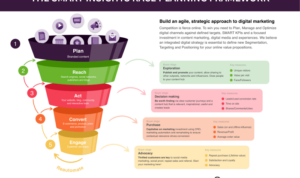Effective Cross-Promotion Strategies pave the way for business success, diving into the realm of collaboration and creativity. Get ready to explore innovative tactics and inspiring stories that will elevate your marketing game.
From identifying target audiences to creating engaging content, this guide will equip you with the tools and insights needed to revolutionize your cross-promotion approach.
Overview of Effective Cross-Promotion Strategies
Cross-promotion in the marketing context refers to the collaboration between two or more businesses to promote each other’s products or services. This can be done through various channels such as social media, email marketing, in-store promotions, or joint events.
Implementing effective cross-promotion strategies is crucial for businesses to expand their reach, increase brand awareness, and ultimately drive sales. By partnering with complementary brands, businesses can tap into each other’s existing customer base and leverage their resources to create mutually beneficial campaigns.
Examples of Successful Cross-Promotion Campaigns
- Apple and Nike: Apple partnered with Nike to create the Apple Watch Nike+, combining the functionalities of both brands to target fitness enthusiasts.
- Starbucks and Spotify: Starbucks and Spotify teamed up to offer exclusive music playlists to Starbucks customers, enhancing the in-store experience and driving engagement.
- Coca-Cola and McDonald’s: Coca-Cola and McDonald’s have a long-standing partnership, with Coca-Cola products being exclusively sold at McDonald’s restaurants, reinforcing both brands’ presence in the fast-food industry.
Identifying Target Audience for Cross-Promotion

Identifying the target audience for cross-promotion strategies is crucial for the success of any marketing campaign. By understanding the demographics and preferences of your target audience, businesses can tailor their promotions to reach the right people at the right time.
Methods to Analyze and Understand the Demographics and Preferences of the Target Audience
- Conduct market research: Use surveys, focus groups, and data analytics to gather information about your target audience’s demographics, interests, and behaviors.
- Utilize social media insights: Analyze the engagement metrics on social media platforms to understand the preferences and behaviors of your followers.
- Track website analytics: Monitor website traffic, bounce rates, and conversion rates to gain insights into the demographics of your online audience.
Examples of How Businesses Have Successfully Identified Their Target Audience for Cross-Promotion
- Apple and Nike partnership: Apple and Nike identified their shared target audience of tech-savvy, fitness-oriented individuals and collaborated on cross-promotional campaigns.
- Starbucks and Spotify collaboration: Starbucks and Spotify joined forces to target music-loving coffee drinkers, offering exclusive playlists and promotions to their shared audience.
- Lululemon and SoulCycle partnership: Lululemon and SoulCycle recognized their mutual target audience of fitness enthusiasts and worked together on co-branded events and promotions.
Choosing Suitable Cross-Promotion Partners: Effective Cross-Promotion Strategies
When selecting partners for cross-promotion, it is crucial to consider businesses that align with your target audience and share similar values. Collaboration with complementary businesses can lead to mutual benefits and increased brand awareness.
Criteria for Selecting Suitable Partners
- Relevance: Partner with businesses that offer products or services that complement yours.
- Audience Alignment: Ensure that your partner’s target audience matches yours for maximum impact.
- Brand Image: Choose partners whose brand values and image resonate with your own to maintain brand consistency.
- Reach: Partner with businesses that have a similar or larger reach to expand your audience reach.
Benefits of Collaborating with Complementary Businesses
- Expanded Reach: Partnering with complementary businesses allows you to tap into new audiences and increase brand visibility.
- Increased Credibility: Associating with reputable partners can enhance your brand’s credibility and trustworthiness.
- Cost-Effective Marketing: Cross-promotion partnerships can be a cost-effective way to reach a larger audience without significant marketing expenses.
Examples of Successful Cross-Promotion Partnerships
1. Nike and Apple: Nike partnered with Apple to create a fitness tracking app that syncs with Nike’s products, benefiting both brands by combining technology and fitness.
2. Starbucks and Spotify: Starbucks collaborated with Spotify to create curated playlists for in-store music, enhancing the overall customer experience and driving engagement for both brands.
3. GoPro and Red Bull: GoPro and Red Bull teamed up to create thrilling extreme sports videos, showcasing the capabilities of GoPro cameras while promoting Red Bull’s high-energy brand image.
Creating Engaging Cross-Promotion Content
Creating engaging cross-promotion content is crucial to capturing the attention of your target audience and driving successful collaborations with your partners. To ensure your content stands out and resonates with your audience, consider the following tips:
Tips for Creating Engaging Cross-Promotion Content
- Focus on storytelling: Craft a narrative that connects with your audience emotionally and showcases the value of the products or services being promoted.
- Utilize visual elements: Incorporate eye-catching graphics, videos, and images to make your content more visually appealing and engaging.
- Add a call to action: Encourage your audience to take a specific action, such as visiting a website, making a purchase, or engaging with your social media channels.
- Keep it authentic: Ensure that the content aligns with your brand’s voice and values to maintain authenticity and credibility.
- Create interactive experiences: Engage your audience through quizzes, polls, contests, or other interactive elements to make the cross-promotion more fun and memorable.
Importance of Aligning Brand Messaging and Values
When creating collaborative content for cross-promotion, it is essential to align brand messaging and values with your partners to ensure consistency and coherence. By maintaining a unified message and shared values, you can establish a cohesive brand identity that resonates with your audience and builds trust. Collaborative content that reflects the values and mission of both brands can create a more compelling and impactful message that drives engagement and loyalty among consumers.
Examples of Creative Cross-Promotion Content
One great example of creative cross-promotion content is the collaboration between Nike and Apple for the Nike+ running app. By integrating Apple’s technology with Nike’s fitness expertise, the two brands created a seamless and engaging experience for users, blending the best of both worlds. Another example is the partnership between Spotify and Starbucks, where Starbucks customers could influence in-store playlists through the Spotify app, creating a fun and interactive way to connect with music lovers and coffee enthusiasts alike.
Leveraging Different Platforms for Cross-Promotion
When it comes to cross-promotion strategies, utilizing different platforms can significantly enhance your reach and visibility among a diverse audience. By leveraging various channels, businesses can amplify their marketing efforts and create a more impactful presence in the market.
Exploring Various Platforms for Cross-Promotion
Businesses can take advantage of a wide range of platforms for cross-promotion, including social media networks, email marketing, influencer collaborations, and even traditional advertising channels. Each platform offers unique opportunities to connect with different segments of the target audience.
- Social Media Networks: Platforms like Facebook, Instagram, Twitter, and LinkedIn provide a direct way to engage with followers and share cross-promotional content.
- Email Marketing: Sending out newsletters or promotional emails to your subscriber list can help drive traffic to your partner’s platform and vice versa.
- Influencer Collaborations: Partnering with influencers in your industry can extend your reach to their followers and introduce your brand to a new audience.
- Traditional Advertising Channels: Utilizing TV, radio, print, or outdoor advertising can complement your digital efforts and reach a broader demographic.
Advantages of Using Multiple Platforms for Cross-Promotion, Effective Cross-Promotion Strategies
By utilizing multiple platforms for cross-promotion, businesses can benefit from increased brand visibility, enhanced credibility, and improved engagement with their target audience. Diversifying the channels used for promotion also reduces the risk of missing out on potential customers who may not be active on a specific platform.
- Increased Brand Visibility: Being present on multiple platforms increases the chances of reaching a wider audience and staying top of mind among consumers.
- Enhanced Credibility: Collaborating with partners across various channels can help reinforce your brand’s credibility and authority in the industry.
- Improved Engagement: Engaging with customers on different platforms allows for more interactive and personalized communication, fostering stronger relationships.
Examples of Businesses Leveraging Different Platforms for Cross-Promotion
Companies like Nike have successfully leveraged multiple platforms for cross-promotion by partnering with athletes on social media, running targeted email campaigns, and featuring their products in TV commercials. This integrated approach has helped Nike reach a diverse audience and drive brand awareness across various demographics.
Measuring the Success of Cross-Promotion Campaigns

To determine the effectiveness of cross-promotion campaigns, businesses need to establish key performance indicators (KPIs) that align with their goals and objectives. These KPIs serve as benchmarks to measure the success of their strategies and initiatives.
Key Performance Indicators (KPIs)
- Evaluation of website traffic: Tracking the increase in website visits resulting from cross-promotion efforts.
- Social media engagement: Monitoring likes, shares, comments, and overall interaction on social platforms.
- Conversion rates: Analyzing the percentage of leads or sales generated through cross-promotion activities.
- Brand awareness: Measuring the growth in brand visibility and recognition among the target audience.
Tools and Methods for Tracking and Analyzing
- Google Analytics: Utilizing this tool to track website traffic, user behavior, and conversions.
- Social media analytics: Leveraging platform-specific insights to evaluate engagement and reach.
- CRM systems: Integrating customer relationship management systems to monitor lead generation and conversion rates.
Examples of ROI Evaluation
- A clothing brand collaborating with a popular influencer tracked a 30% increase in online sales during the cross-promotion period, attributing the growth directly to the partnership.
- A tech startup measured a 50% rise in website traffic following a cross-promotion campaign with a complementary software company, indicating a successful reach to a new audience segment.
- A local cafe observed a 20% boost in social media engagement after partnering with a nearby bookstore for a joint promotion, showcasing the impact of cross-promotion on brand visibility.












